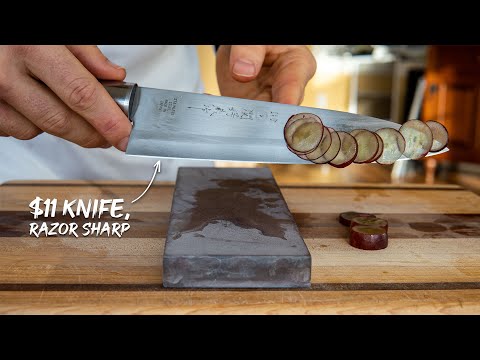
dca8a0116ebf4e38318a3e866adfd11c
Welcome to the ultimate guide to sharpening stones for knives! Whether you’re a professional chef, a home cook, or a knife enthusiast, having a sharp knife is essential for any kitchen. Sharpening stones are the best way to keep your knives in top condition, and this guide will provide you with all the information you need to choose the right sharpening stone for your knives. We’ll discuss the different types of sharpening stones, the best techniques for sharpening knives, and the best products on the market. With this guide, you’ll be able to keep your knives sharp and ready for any task.
What knife sharpening stones do I need
Sharpening a knife is an important part of knife maintenance. It is important to use the right sharpening stones to ensure that your knife is sharpened correctly. There are a variety of sharpening stones available, so it is important to know which ones you need for your knife.
Types of Sharpening Stones
The most common types of sharpening stones are water stones, oil stones, and diamond stones. Water stones are made of aluminum oxide or silicon carbide and require water for lubrication. Oil stones are made of aluminum oxide or silicon carbide and require oil for lubrication. Diamond stones are made of diamond particles and require no lubrication. Each type of stone has its own advantages and disadvantages.
Choosing the Right Stone
When choosing a sharpening stone, it is important to consider the type of knife you are sharpening. For example, if you are sharpening a kitchen knife, a water stone or oil stone would be the best choice. If you are sharpening a pocket knife, a diamond stone would be the best choice. It is also important to consider the type of steel your knife is made of. Some stones are better suited for certain types of steel.
Sharpening Technique
Once you have chosen the right stone for your knife, it is important to use the correct sharpening technique. Start by wetting the stone with water or oil, depending on the type of stone you are using. Place the knife on the stone at a 20-degree angle and move the blade in a circular motion. Make sure to keep the angle consistent throughout the sharpening process. Once you have finished sharpening, rinse the knife and stone with water.
Conclusion
Choosing the right sharpening stone for your knife is an important part of knife maintenance. Water stones, oil stones, and diamond stones are the most common types of sharpening stones. It is important to consider the type of knife and steel when choosing a stone. Once you have chosen the right stone, use the correct sharpening technique to ensure that your knife is sharpened correctly.
How do I know what sharpening stone to use
Sharpening stones are an essential tool for keeping your knives and tools sharp. But with so many different types of sharpening stones available, it can be difficult to know which one is right for you. In this article, we’ll discuss the different types of sharpening stones and how to choose the right one for your needs.
Types of Sharpening Stones
The most common types of sharpening stones are oil stones, water stones, and diamond stones. Oil stones are the most traditional type of sharpening stone and are made from aluminum oxide or silicon carbide. They are usually used with oil or water as a lubricant. Water stones are made from synthetic or natural materials and are usually used with water as a lubricant. Diamond stones are made from diamond particles and are the most expensive type of sharpening stone. They are usually used dry.
Choosing the Right Sharpening Stone
When choosing a sharpening stone, it’s important to consider the type of material you’ll be sharpening. For example, if you’re sharpening a knife made from stainless steel, you’ll need a different type of stone than if you’re sharpening a knife made from carbon steel. Additionally, you’ll need to consider the type of edge you want to achieve. If you want a very sharp edge, you’ll need a finer grit stone. If you want a more durable edge, you’ll need a coarser grit stone.
Conclusion
Choosing the right sharpening stone can be a daunting task, but with a little research and knowledge, you can find the perfect stone for your needs. Consider the type of material you’ll be sharpening, the type of edge you want to achieve, and the type of lubricant you’ll be using. With the right sharpening stone, you can keep your knives and tools sharp and in top condition.
How do you use a knife sharpening stone with a guide
Sharpening a knife is an important part of kitchen maintenance. A sharp knife is safer and more efficient to use than a dull one. A knife sharpening stone is a great tool for keeping your knives sharp and in good condition. Using a knife sharpening stone with a guide can make the process easier and more precise.
Steps for Using a Knife Sharpening Stone with a Guide
Step 1: Gather the Necessary Materials
Before you begin sharpening your knife, make sure you have all the necessary materials. You will need a knife sharpening stone, a guide, a honing oil, and a cloth.
Step 2: Secure the Guide
Secure the guide to the sharpening stone. The guide should be placed at the desired angle for sharpening. This angle will depend on the type of knife you are sharpening.
Step 3: Apply the Honing Oil
Apply a few drops of honing oil to the sharpening stone. This will help to lubricate the stone and prevent it from becoming clogged with metal particles.
Step 4: Sharpen the Knife
Place the knife blade against the guide and begin to move it back and forth across the stone. Make sure to keep the blade at the same angle as the guide. Move the blade in a slow, steady motion.
Step 5: Check the Edge
After a few passes, check the edge of the knife to make sure it is sharp. If it is not sharp enough, repeat the process until it is.
Step 6: Clean the Knife
Once the knife is sharp, use a cloth to wipe off any excess honing oil.
Conclusion
Using a knife sharpening stone with a guide is a great way to keep your knives sharp and in good condition. With a few simple steps, you can easily sharpen your knives and keep them in top condition.
Should aluminum oxide stones be wet or dry
Aluminum oxide stones are a popular choice for sharpening knives and other tools. They are available in both wet and dry varieties, and each has its own advantages and disadvantages. It is important to understand the differences between wet and dry aluminum oxide stones in order to make an informed decision about which type is best for your needs.
Wet Aluminum Oxide Stones
Wet aluminum oxide stones are typically used for honing and polishing. They are usually softer than dry stones, which makes them ideal for honing and polishing delicate edges. The water helps to lubricate the stone and reduce friction, which can help to prevent damage to the blade. Wet stones also tend to last longer than dry stones, as they are less prone to wear and tear.
Dry Aluminum Oxide Stones
Dry aluminum oxide stones are typically used for sharpening. They are usually harder than wet stones, which makes them ideal for sharpening blades. The lack of water helps to reduce the risk of rusting, which is important when sharpening knives. Dry stones also tend to be more aggressive than wet stones, which can help to quickly sharpen a dull blade.
Which is Better?
The answer to this question depends on the type of work you are doing. If you are honing and polishing delicate edges, then a wet aluminum oxide stone is probably the best choice. If you are sharpening a dull blade, then a dry stone is probably the better option. Ultimately, it is important to consider the type of work you are doing and choose the stone that is best suited for the job.
We hope this guide has been helpful in understanding the basics of sharpening stones for knives. We wish you the best of luck in finding the perfect stone for your knife sharpening needs. Goodbye and happy sharpening!













